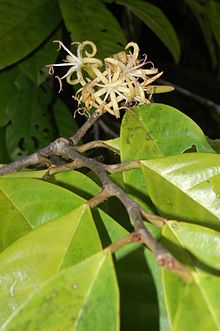
The Malpighiales comprise one of the largest orders of flowering plants. The order is very diverse, with well-known members including willows, violets, aspens and poplars, poinsettia, corpse flower, coca plant, cassava, flaxseed, castor bean, Saint John's wort, passionfruit, mangosteen, and manchineel tree.

Altingiaceae is a small family of flowering plants in the order Saxifragales, consisting of wind-pollinated trees that produce hard, woody fruits containing numerous seeds. The fruits have been studied in considerable detail. They naturally occur in Central America, Mexico, eastern North America, the eastern Mediterranean, China, and tropical Asia. They are often cultivated as ornamentals and many produce valuable wood.

The rosids are members of a large clade of flowering plants, containing about 70,000 species, more than a quarter of all angiosperms.

Peridiscaceae is a family of flowering plants in the order Saxifragales. Four genera comprise this family: Medusandra, Soyauxia, Peridiscus, and Whittonia., with a total of 12 known species. It has a disjunct distribution, with Peridiscus occurring in Venezuela and northern Brazil, Whittonia in Guyana, Medusandra in Cameroon, and Soyauxia in tropical West Africa. Whittonia is possibly extinct, being known from only one specimen collected below Kaieteur Falls in Guyana. In 2006, archeologists attempted to rediscover it, however, it proved unsuccessful.

Tofieldiaceae is a family of flowering plants in the monocot order Alismatales. The family is divided into four genera, which together comprise 28 known species. They are small, herbaceous plants, mostly of arctic and subarctic regions, but a few extend further south, and one genus is endemic to northern South America and Florida. Tofieldia pusilla is sometimes grown as an ornamental.

James Lauritz Reveal was a U.S. botanist best known for his contributions to the genus Eriogonum and for his work on suprageneric names. His website, at PlantSystematics.org, also presents material on plant taxonomy including the Reveal system. He published extensively on North American flora, was a member of the Angiosperm Phylogeny Group, and was one of the authors of the APG II and APG III classifications.

Huerteales is the botanical name for an order of flowering plants. It is one of the 17 orders that make up the large eudicot group known as the rosids in the APG III system of plant classification. Within the rosids, it is one of the orders in Malvidae, a group formerly known as eurosids II and now known informally as the malvids. This is true whether Malvidae is circumscribed broadly to include eight orders as in APG III, or more narrowly to include only four orders. Huerteales consists of four small families, Petenaeaceae, Gerrardinaceae, Tapisciaceae, and Dipentodontaceae.

The Icacinaceae, also called the white pear family, are a family of flowering plants, consisting of trees, shrubs, and lianas, primarily of the tropics.

Calatola columbiana is a species of flowering plant in the family Metteniusaceae. It was formerly placed in the family Icacinaceae. It is endemic to Colombia.

Calatola is a genus of flowering plants in the family Metteniusaceae. It was formerly placed in the family Icacinaceae. Its range is from Mexico to Peru. There are nine species. The type species is Calatola mollis.
Metteniusa cundinamarcensis is a species of flowering plants in the family Metteniusaceae. It was formerly placed in the family Cardiopteridaceae. It is endemic to Colombia.
Metteniusa edulis is a species of flowering plants in the family Metteniusaceae. It was formerly placed in the family Cardiopteridaceae. It is endemic to Colombia.
Metteniusa huilensis is a species of flowering plants in the family Metteniusaceae. It was formerly placed in the family Cardiopteridaceae. It is endemic to Colombia.
Metteniusa santanderensis is a species of flowering plants in the family Metteniusaceae. It was formerly placed in the family Cardiopteridaceae. It is endemic to Colombia.

Cardiopteridaceae is a eudicot family of flowering plants. It consists of about 43 species of trees, shrubs, and woody vines, mostly of the tropics, but with a few in temperate regions. It contains six genera, the largest of which is Citronella, with 21 species. The other genera are much smaller.
When the APG II system of plant classification was published in April 2003, fifteen genera and three families were placed incertae sedis in the angiosperms, and were listed in a section of the appendix entitled "Taxa of uncertain position".

Tetracarpaea is the only genus in the flowering plant family Tetracarpaeaceae. Some taxonomists place it in the family Haloragaceae sensu lato, expanding that family from its traditional circumscription to include Penthorum and Tetracarpaea, and sometimes Aphanopetalum as well.

Metteniusaceae are a family of flowering plants, the only family in the order Metteniusales. It consists of about 10 genera and 50 species of trees, shrubs, and lianas, primarily of the tropics. The family was formerly restricted to just Metteniusa, but it is now expanded with a number of genera that were formerly placed in the widely polyphyletic Icacinaceae.

Emmotum is a genus of flowering plants in the family Metteniusaceae. It was formerly placed in the family Icacinaceae. It has about 13 species. One of these species, E. harleyi, was described in 2007.

The Lophiocarpaceae are a family of flowering plants comprising mostly succulent subshrubs and herbaceous species native to tropical to southern sub-Saharan Africa to western India. It includes the genera Corbichonia and Lophiocarpus. The family is newly recognized through research by the Angiosperm Phylogeny Group III system to deal with long-standing phylogenetic difficulties in placing various genera within the Caryophyllales.














